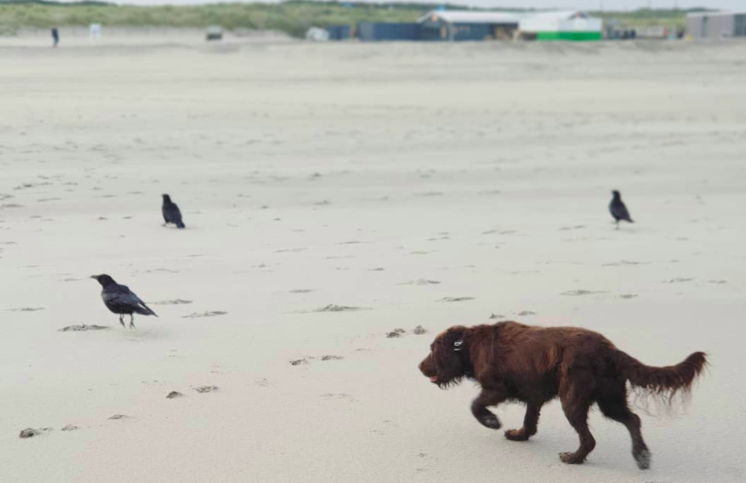Lucas Brand

In their book ‘Dogs: a new understanding of canine origin, behavior and evolution’ Coppinger and Coppinger (2001) explain that motor patterns are innate complex reflexive behaviours evoked by a releaser and have a species specific, stereotypic, shape. They state that the distinctiveness of these patterns means biologists can determine which predator killed the prey by looking at the carcass and argue that motor patterns don’t differ in kind amongst species or breeds, but rather differ in the frequency of expression. The full wolf predatory motor sequence (PMS) is said to be; orient > eye > stalk > chase > grab-bite > kill-bite > dissect > consume. This sequence is used as template for that of the domestic dog. But is the sequence as reflexive as they state? And is this PMS template useful for us as dog trainers and behaviourists?
The predatory motor sequence, how about dogs?
According to Coppinger and Coppinger (2001) there is one predatory motor sequence for general carnivores, which is adapted by species as different niches. The wolf-PMS, mainly based on groups hunting for ungulates, is an adapted, niche, version of that of a general carnivore.
But wolves also hunt for smaller animals such as birds or hare. How would this affect the predatory motor sequence? Within the species-specific PMS, patterns can be substituted. For example the chase pattern could be substituted by a fore-foot stab, used to hunt small critter, creating an altogether different sequence for a different type of hunting-purpose. They also explain that they can start the sequence at any pattern, meaning a wolf can start the sequence at stalk or chase, without first going through the motions of orient and eye.
But wolves also hunt for smaller animals such as birds or hare. How would this affect the predatory motor sequence? Within the species-specific PMS, patterns can be substituted. For example the chase pattern could be substituted by a fore-foot stab, used to hunt small critter, creating an altogether different sequence for a different type of hunting-purpose. They also explain that they can start the sequence at any pattern, meaning a wolf can start the sequence at stalk or chase, without first going through the motions of orient and eye.
Mainly through the works of Coppinger and studies based on their work, the wolf predatory motor sequence is used as a template for the PMS in the modern domestic dog. The PMS in dogs is said to be atrophied or hypertrophied through artificial selection, making them specialists, as it were, in certain patterns within the sequence. For example Border Collies have exaggerated eye>stalk>chase and Anatolian Shepherds an inhibited sequence of (orient) (eye) (stalk) (chase) (Coppinger, 2001., Udell, 2014).
But wolves and domestic dogs are not one and the same. All dogs share a common ancestry which is distinct from modern wolves, though they do have a common ancestor which is now extinct (Bergstrom et al, 2020). When looking at wolves, we are not looking at our domestic dog’s ancestor, which means we can’t say the wolf PMS is the ancestral PMS in dogs as Coppinger and Coppinger (2001) claim it to be. Modern wolves not being domesticated does not indicate they are more like their ancestor, the environment to which they have adapted might have changed as much as that of the dog.As Miklosi (2007) states, a wolf raised and socialized in a dog’s environment does not become dog-like and feral dogs do not show wolf-like behaviours. One of the differences between modern wolves and domestic dogs lies in their early development during the critical period of socialization, which impacts hunting and hazard avoidance, amongst other factors, and is likely to impact adult behaviour profoundly (Lord, 2012). I believe it is safe to assume that these factors indicate that comparing the PMS of wolves with that of dogs might be problematic. How can we separate the differences, both genetic and environmental, between dogs and wolves if we don’t have enough data about their common ancestor?
One way to overcome this issue is through the use of a ethocognitive model, as this can help us observe and research the role and interaction between genetic and environmental factors. The model looks at how genetic and environmental components occur and are intertwined, from the perceptual information input, via a referential system, to elicit an action system (behavioural output) such as a modal action pattern. This system is continuously updated and modified by exploring and monitoring the environment. Looking at which genetic and environmental factors at what stage within the ethocognitive model shape the occurrence of motor patterns might help us design experiments to find out differences and similarities in dog and wolves (Miklosi, 2007).
One way to overcome this issue is through the use of a ethocognitive model, as this can help us observe and research the role and interaction between genetic and environmental factors. The model looks at how genetic and environmental components occur and are intertwined, from the perceptual information input, via a referential system, to elicit an action system (behavioural output) such as a modal action pattern. This system is continuously updated and modified by exploring and monitoring the environment. Looking at which genetic and environmental factors at what stage within the ethocognitive model shape the occurrence of motor patterns might help us design experiments to find out differences and similarities in dog and wolves (Miklosi, 2007).
